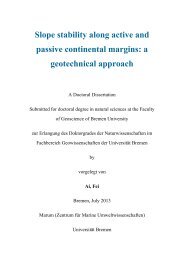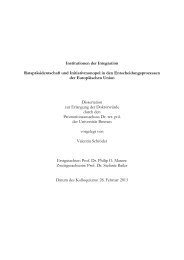Seismoacoustic Study of the Shallow Gas Transport and ... - E-LIB
Seismoacoustic Study of the Shallow Gas Transport and ... - E-LIB
Seismoacoustic Study of the Shallow Gas Transport and ... - E-LIB
Create successful ePaper yourself
Turn your PDF publications into a flip-book with our unique Google optimized e-Paper software.
Abstract<br />
Abstract<br />
In recent years, gas release through seabed fluid seepage has received increasing<br />
attention from geoscientists. On <strong>the</strong> one h<strong>and</strong> it contributes greater amounts <strong>of</strong> gas <strong>and</strong><br />
fluids, dominated by methane (a powerful greenhouse gas) to <strong>the</strong> biosphere, <strong>the</strong><br />
hydrosphere <strong>and</strong> <strong>the</strong> atmosphere. It can also cause marine geohazards such as slope<br />
failures, or can be used to predict <strong>the</strong> presence <strong>of</strong> oil <strong>and</strong> gas fields or gas hydrates fields.<br />
The Black Sea is <strong>the</strong> world’s largest anoxic intercontinental basin with a maximum water<br />
depth <strong>of</strong> 2200 m, which created by a back-arc extension due to <strong>the</strong> subduction <strong>of</strong> <strong>the</strong><br />
Thetyan Ocean during <strong>the</strong> Late Cretaceous period. The collision between <strong>the</strong> Arabian <strong>and</strong><br />
Eurasian plates has led to compressive deformation at <strong>the</strong> margins <strong>of</strong> <strong>the</strong> Black Sea since<br />
<strong>the</strong> Eocene. Combined with thick sediment coverage, a considerable amount <strong>of</strong> gas<br />
related to seabed fluid seepage was generated by over-pressured fluids <strong>and</strong> upward fluid<br />
migration. Two study areas: <strong>the</strong> central Black Sea <strong>and</strong> <strong>the</strong> Kerch Peninsula margin were<br />
selected to fur<strong>the</strong>r investigate <strong>the</strong> shallow expressions <strong>of</strong> such gas transport <strong>and</strong> release.<br />
Mainly high-resolution multichannel seismic datasets were used to study <strong>the</strong> near-surface<br />
seismostratigraphy, complemented by bathymetric <strong>and</strong> sediment echosounder (Parasound)<br />
data. The datasets <strong>of</strong> <strong>the</strong> central Black Sea were collected during <strong>the</strong> Meteor Cruise<br />
M52/1 in 2002. The datasets <strong>of</strong> <strong>the</strong> Kerch Peninsula margin were acquired during <strong>the</strong><br />
Meteor Cruise M72/3b in 2007.<br />
In <strong>the</strong> central Black Sea, six large mud volcanoes: MSU, Yuzhmorgeologiya,<br />
Malyshev, Kornev, Goncharov <strong>and</strong> Vassoevitch with great morphological variability <strong>and</strong><br />
clear near-surface sediment structures were imaged by high-resolution seismic data. <strong>Gas</strong><br />
discharge is commonly associated with mud volcanism. As gas emissions at mud<br />
volcanoes are dominated by methane, mud volcanoes represent an important natural<br />
source <strong>of</strong> methane contribution to <strong>the</strong> environment. Four types <strong>of</strong> pathways for gas <strong>and</strong><br />
fluid migration <strong>and</strong> three types <strong>of</strong> gas reservoirs were recognized, according to <strong>the</strong><br />
analysis <strong>of</strong> acoustic anomalies <strong>and</strong> studied near-surface sediment structures <strong>of</strong> <strong>the</strong>se mud<br />
volcanoes. The formation history <strong>of</strong> <strong>the</strong> gas reservoirs was studied in detail, which<br />
reveals that <strong>the</strong> free gas reservoirs were probably sealed by gas hydrates or fine-grained<br />
sediments. Two to three major eruption episodes <strong>of</strong> <strong>the</strong>se mud volcanoes were observed.<br />
These eruptive episodes appeared be related to distinct sea level falls during <strong>the</strong><br />
Pleistocene, which seem to be one <strong>of</strong> <strong>the</strong> main trigger factors <strong>of</strong> <strong>the</strong> mud volcano<br />
eruptions in <strong>the</strong> central Black Sea.<br />
The Parasound sediment echosounder data collected in <strong>the</strong> Kerch Peninsula margin<br />
during cruise M72/3b presented many gas flares located on <strong>the</strong> continental slope in water<br />
depths shallower than ~700 m, which is <strong>the</strong> upper boundary <strong>of</strong> <strong>the</strong> gas hydrate stability<br />
zone (GHSZ). <strong>Gas</strong> flares <strong>of</strong> more than ~400 m height above <strong>the</strong> sea floor were observed<br />
at a water depth <strong>of</strong> ~900 m within <strong>the</strong> GHSZ, which was named as <strong>the</strong> Kerch seep area.<br />
Strong evidence was found in seismoacoustic water column <strong>and</strong> subsurface data for free<br />
gas, distributed in numerous bright spots within, beneath <strong>and</strong> above <strong>the</strong> GHSZ. The<br />
presence <strong>of</strong> gas hydrates in conjunction with <strong>the</strong> deformation history <strong>of</strong> <strong>the</strong> sedimentary<br />
units appears as <strong>the</strong> main factor <strong>of</strong> gas distribution, migration <strong>and</strong> seepage. Therefore, six<br />
seismic units in terms <strong>of</strong> <strong>the</strong>ir approximate geological ages, seismic facies character <strong>and</strong><br />
distribution, depocenter locations, provenance, <strong>and</strong> tectonic movement <strong>of</strong> <strong>the</strong> Crimean<br />
1
















